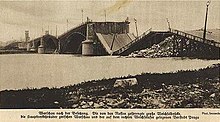Poniatowski Bridge
This article needs additional citations for verification. (November 2021) |
52°14′10″N 21°02′30″E / 52.23611°N 21.04167°E
Poniatowski Bridge Most Poniatowskiego | |
|---|---|
Deck arch bridge | |
| Material | Steel |
| Total length | 506 metres (1,660 ft) |
| Width | 21.40 metres (70.2 ft) |
| Longest span | 80 metres (260 ft) |
| No. of spans | 8 |
| History | |
| Architect | Stefan Szyller |
| Engineering design by | Mieczysław Marszewski, Wacław Paszkowski |
| Constructed by | K. Rudzki i S-ka |
| Construction start | 1904 |
| Opened | 6 January 1914 |
| Location | |
 | |
The Poniatowski Bridge (
Jerusalem Avenue
, a principal Warsaw thoroughfare.
History
The 506 m long steel bridge, consisting of eight
Governor General, Georgi Skalon, as Warsaw's third bridge; hence it was nicknamed "third bridge" (Polish: "trzeci most") by the city's residents, though its official name was Bridge of Our Most Gracious Ruler, Tsar Nicholas II (Warsaw then being part of the Russian Empire, following the 18th-century partitions of Poland). After Poland regained independence in 1918, the bridge was renamed after Prince Józef Poniatowski
and acquired a new nickname — "Poniatoszczak" — which it retains to this day.


The bridge suffered much during the
coup, Marshal of Poland Józef Piłsudski. During the Second World War the bridge was destroyed by German troops during the Warsaw Uprising, on 13 September 1944. That demolition was much more complete: all spans were toppled, and only the lower piers
survived.
The first post-war plans by the new (communist) Polish government provided for the construction of a wooden temporary structure on the surviving pillars, but hasty work caused the bridge to collapse. Restored again on new pillars, the bridge was reopened again on 22 July 1946 by
Polish renaissance
features, such as the hand-made balustrades or stone benches. Some of the old pre-war benches, as well as one of the old spans, can be seen in the water near the bridge at low tide.
In 1949, under the direction of Eng. Tadeusz Chyliński of the Institute of Aviation, stain gauge measurements of stresses in the bridge spans were carried out during test loading.

Between 1963 and 1966 the bridge was widened, a
Świętokrzyski Bridge
in 2000).
In 2004 a reconstruction and beautification program of the bridge began. By 2005 the small towers and the first four spans had been rebuilt. The tramway track was modernized and rebuilt in 2007.
Gallery
-
Viaduct and small towers - north side, 1914
-
Viaduct and small towers - south side, 1914
-
The bridge before the First World War, 1914.
-
The bridge before the First World War, 1914.
-
Bridge being rebuilt shortly before the fire of 1915
-
Poniatowski Bridge after being blown up by the Russian Army in 1915
-
Marshall Józef Piłsudski on Poniatowski Bridge, 1926.
-
The bridge in the interwar period (1936 or earlier).
-
Poniatowski Bridge - from below.
-
Poniatowski Bridge - from the river.
See also
- Łazienkowski Bridge
- Siekierkowski Bridge
- Świętokrzyski Bridge
References
- One Unlucky Bridge, Warsaw Voice, 1 July 2001
- River Vistula recently came into operation in Warsaw...". Autocar. Vol. 125 (nbr 3679). 19 August 1966. p. 412.
External links
- Satellite view from Google Map
Wikimedia Commons has media related to Poniatowski Bridge.










